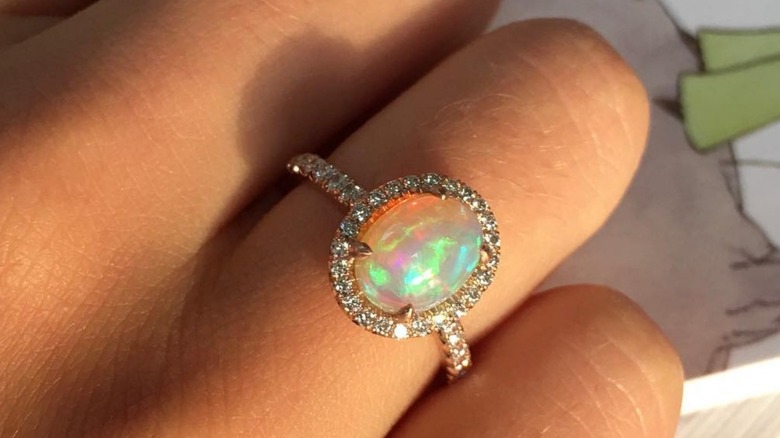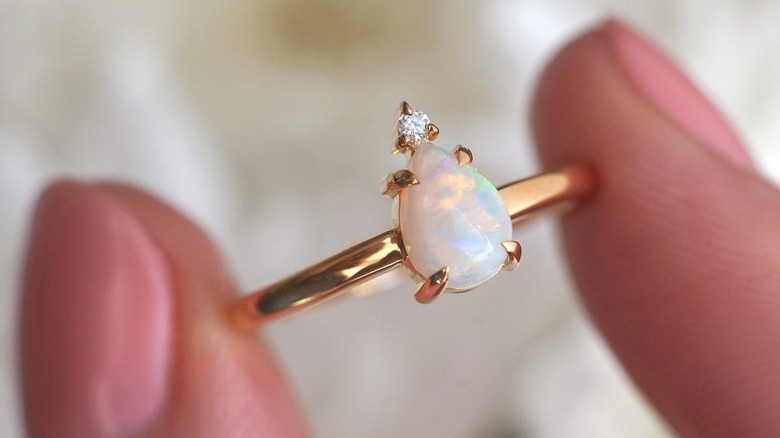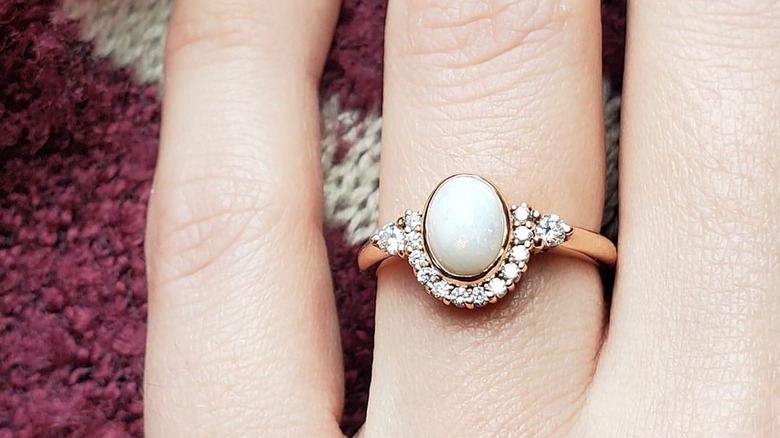Why You Should Think Twice Before Getting An Opal Engagement Ring
Engagement rings symbolize devotion and the adoration one has for their significant other. Although diamonds will forever be a classic choice, opal engagement rings have become popular among individuals looking for something more unique and modern. Opals come in various hues, including translucent, black, gray, blue, orange, and more. Likewise, they are known for their rainbow shimmer, referred to as "play of color," and for being the birthstone of October. If you're a history lover, opals carry even more significance. This gemstone was a favorite amongst royalty, such as Queen Victoria and Cleopatra.
Jewelry designer Misa Hamamoto explained the appeal of opal engagement rings to Brides. She said, "You can't deny the wondrous beauty within an opal. Each opal is truly one-of-a-kind, which is fitting for the one-of-a-kind bride." Hamamoto added, "The wonderful thing about opal jewelry is not only that they're absolutely stunning, but they are much more budget-friendly than big diamond rings." While white opal rings can cost a few hundred dollars, black opal rings are more expensive. If you're looking for something that won't break the bank or if you love the look of an opal engagement ring, then you should be aware of the cons of this lovely gemstone.
Opals do not last a lifetime
Opals are formed when rainwater evaporates from underground rocks and leaves behind silica. Aesthetically speaking, opals are incredibly distinct. Misa Hamamoto noted, "For the untraditional non-diamond bride, opals make the perfect engagement ring because they display a different kind of sparkle than a diamond — a magical, iridescent sparkle." So, what's the catch with opal engagement rings? For all their beauty and affordability, they are perhaps not the best choice to be your forever ring. Unfortunately, they can break and scratch easily. For this reason, they are not recommended for everyday use. In fact, they are as fragile as glass (via Frank Darling).
Opals clock in between a 5-6.5 range on the Mohs scale, which measures the hardness of minerals and gemstones. The higher a gemstone is on the scale, the more its resistant to scratching. In comparison, diamonds are a 10, rubies and sapphires a 9, and emeralds an 8. Ultimately, this means that opals are soft and delicate. Moreover, anything above an opal on the Mohs scale can scratch it. This is important to consider if you use the same cloth to wipe your opal and another gemstone, such as quartz or topaz. Exposure to oil and lotion could also negatively affect an opal engagement ring.
How to care for your opal engagement ring
If you are unmoved by the drawbacks of opal engagement rings and have your heart set on one, there are ways to prolong their longevity. Misa Hamamoto explained, "We advise that you wear your opal jewelry with great care and love so they become future heirlooms." She continued, "Don't submerge them under water, don't apply harsh cleaning agents to them, and don't go rock climbing with them! (One of our clients did this and they learned the hard way)." Make sure to remove your opal engagement ring while exercising, washing dishes, or swimming. Do not leave your ring in direct sunlight or other heat sources.
Water or liquids are opal's worst enemy; never soak it. To clean your engagement ring, use a washcloth with mild soap. Let it dry out if you accidentally submerge your opal ring in liquid. Do not use heat, such as a hairdryer, as this can cause your opal to break or crack.
The design choice is also significant. For example, a bezel setting is more likely to protect your opal stone than others. If this sounds too daunting, you can use opal as an accent stone instead of choosing it as your engagement ring centerpiece.


